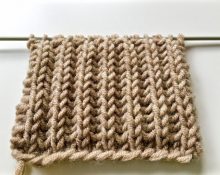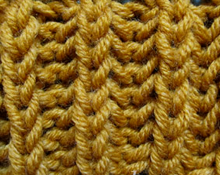One of the most famous knitting techniques, and also wonderfully suitable for creating winter accessories, is the English rib. This is a double-sided pattern, embossed and warm. With its help, incredible, very elastic things are created. I will tell you how to insulate yourself with a scarf knitted with an English elastic band in this article.

Features of knitting scarves with English elastic
Scarves are one of the few knitted items where both the front and back sides are very important. After all, it wraps around the neck, and the same pattern of the canvas is needed here more than anywhere else. Moreover, when knitting with this pattern The result is very soft and loose things - exactly what you need for scarves.
Products knitted with English elastic make you want to wrap yourself more closely, and their softest touches bring exceptionally pleasant emotions. The main point that should be taken into account when choosing this pattern is the high consumption of yarn due to yarn overs.They make the English elastic airy and fluffy, but this happens by increasing the amount of thread used.
Interesting! This type of elastic band is also called “patent”. In general, this name is given to a whole group of patterns - patent elastic bands. These are various variations of an elastic pattern using yarn overs. Imagine how popular the English elastic is if it gave its name to a whole group of similar patterns.
When knitting scarves, special attention should be paid to the edge loops. If you knit them in the usual way, without knitting the first and knitting the last knit or purl, the edge will turn out sloppy and loose. To prevent this from happening, you need to select not 2, but 4 loops for the edge loops. Please take this into account when recruiting.

Yarn selection
Of course, you should give preference to winter yarn, i.e. with a certain content of natural wool in the composition. It is ideal if the threads contain mohair: then the product, after wet-heat treatment, will fluff up and become even warmer. Depending on how thin or, on the contrary, how voluminous the product you want to get, you need to choose yarn of a certain thickness. Know that even a thin thread with a good composition (for example, merino wool) will help create a very warm product.
Threads of different thicknesses, types of twist and composition will look different in the finished scarf. Wool blend yarn with acrylic in its composition usually does not fluff up much, and the fabric turns out to be more voluminous. Whereas the addition of natural, although not warm, fibers (for example, viscose or silk) makes the finished product softer and smoother.
Mohair, as I said earlier, will help make the scarf fluffy, which will only benefit its thermal characteristics.The composition of the yarn can be very different; some will combine merino wool, viscose, mohair, and lurex. The imagination of knitting thread manufacturers can be said to be limitless. So the choice here is only yours.

Deciding on a pattern
The English elastic band itself, as a pattern, cannot change, but if you approach the issue of choosing yarn or its arrangement creatively, the fabric will be strikingly different. So, for example, choosing melange yarn for the creative process (when the thread changes color along its length), you will get a canvas with color transitions.
A scarf made of different matching colors would also be interesting. These can be stripes or geometric shapes. A jacquard pattern on an English elastic band will not look very interesting. A special option is a two-color English elastic band. It creates a canvas striped along the rows, which looks very advantageous.

@uzelok.su
Detailed master class
A scarf is a product that is knitted in turning rows. If you knit it in a circle, it will become not a scarf, but a snood. To know exactly how many loops are needed for the width of the scarf you have planned, I strongly recommend casting on a sample and performing a WTO. Then we cast on the required number of loops on the knitting needles in the classic way.
- Place the working thread between the first two edge loops. The first of them is thrown onto the right knitting needle, the thread is wound into work, the next loop is knitted.
- We knit the 1st row of English elastic - 1 front stitch + yarn over + remove the next loop.
- At the end of the row (2 edge stitches remain), the thread is thrown forward, the first stitch of the edge stitches is removed, and the last stitch is knitted. All edges will be knitted as described in the first paragraph and in this one.
- The front loop is knitted with the knit yarn over made in the last row + yarn over + remove the purl loop. If an even number of stitches was initially cast on, all subsequent rows are knitted as in step 3.
- Having knitted the required length, close the loops. To do this, first switch to a regular 1*1 elastic band. We remove the first edge (thread between the edges), then knit 2 knit stitches and 1 purl stitch. After this, knit stitches with yarn overs from the previous row are knitted with knit stitches, and purl stitches are knitted with purl stitches. At the end of the row, the first of the edges is purl, the last is knit. In the next row we knit 2 loops together, returning the resulting stitch to the left knitting needle. At the same time, we knit the knit stitches with the knit stitches, and the purl stitches with the purl stitches.
It seems that English elastic is simply created for scarves. This is a neat, voluminous, beautiful double-sided pattern that allows you to knit an elastic fabric that is the same on both sides. By changing the type of yarn and combining it at your discretion, you can create a unique product that will perfectly warm you in the cold winter.


 0
0





